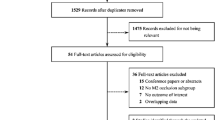Abstract
Background and purpose
The efficacy and safety of mechanical thrombectomy (MT) for M2 segment occlusion of middle cerebral artery in patients with acute ischemic stroke (AIS) was investigated.
Methods
We searched PubMed and EMBASE from inception to 16 April 2019 for relevant studies, calculated the pool relative risks (RRs) of 3-month functional independence (modified Rankin scale score 0–2), death and symptomatic intracerebral hemorrhage (sICH) in MT for M2 segment occlusion in patients with AIS versus those of M1 segment or best medical care.
Results
Nine studies enrolling 2152 patients compared MT for patients with AIS of M2 segment occlusion and those of M1 segment occlusion. MT for M2 occlusion had a higher rate of 3-month functional independence compared to the patients with M1 occlusion. (RR 1.27, 95% CI 1.11–1.44, P < 0.001) and decreased death (RR 0.74; 95% CI 0.58–0.96, P = 0.022) with similar risk of sICH (RR 1.11; 95% CI 0.65–1.87, P = 0.707). Four studies enrolling 1016 patients compared MT and best medical care for patients with AIS of M2 occlusion. MT for M2 occlusion benefit more than best medical care on 3-month functional independence (RR 1.43, 95% CI 1.08–1.90, P = 0.011) and death (RR 0.46; 95% CI 0.22–0.96, P = 0.022) with similar risk of sICH (RR 1.65; 95% CI 0.66–4.13; P = 0.286).
Conclusion
MT for M2 segment benefit patients with AIS on 3-month functional independence compared with that of M1 segment or medical care, without increasing the risk of sICH.




Similar content being viewed by others
References
Goyal M, Menon BK, van Zwam WH, Dippel DW, Mitchell PJ, Demchuk AM et al (2016) Endovascular thrombectomy after large-vessel ischaemic stroke: a meta-analysis of individual patient data from five randomised trials. Lancet 387:1723–1731
Salahuddin H, Ramaiah G, Slawski DE, Shawver J, Buehler M, Zaidi SF et al (2018) Mechanical thrombectomy of M1 and M2 middle cerebral artery occlusions. J Neurointerv Surg 10:330–334
Bhogal P, Bücke P, AlMatter M, Ganslandt O, Bäzner H, Henkes H et al (2017) A comparison of mechanical thrombectomy in the M1 and M2 segments of the middle cerebral artery: a review of 585 consecutive patients. Interv Neurol 6:191–198
Coutinho JM, Liebeskind DS, Slater L-A, Nogueira RG, Baxter BW, Levy EI et al (2016) Mechanical thrombectomy for isolated M2 occlusions: a post hoc analysis of the STAR, SWIFT, and SWIFT PRIME studies. AJNR Am J Neuroradiol 37:667–672
Protto S, Sillanpää N, Pienimäki JP, Matkaselkä I, Seppänen J, Numminen H (2016) Stent retriever thrombectomy in different thrombus locations of anterior cerebral circulation. Cardiovasc Interv Radiol 39:988–993. https://doi.org/10.1007/s00270-016-1315-4
Dorn F, Lockau H, Stetefeld H, Kabbasch C, Kraus B, Dohmen C et al (2015) Mechanical thrombectomy of M2-occlusion. J Stroke Cerebrovasc Dis 24:1465–1470
Arnold M, Slezak A, El-Koussy M, Lüdi R, Findling O, Mono ML et al (2015) Occlusion location of middle cerebral artery stroke and outcome after endovascular treatment. Eur Neurol 74:315–321. https://doi.org/10.1159/0004414459
Zangerle A, Kiechl S, Spiegel M, Furtner M, Knoflach M, Werner P et al (2007) Recanalization after thrombolysis in stroke patients: predictors and prognostic implications. Neurology 68:39–44
Saqqur M, Uchino K, Demchuk AM, Molina CA, Garami Z, Calleja S et al (2007) Site of arterial occlusion identified by transcranial Doppler predicts the response to intravenous thrombolysis for stroke. Stroke 38:948–954
Alexandrov AV, Grotta JC (2002) Arterial reocclusion in stroke patients treated with intravenous tissue plasminogen activator. Neurology 59:862–867
Shamseer L, Moher D, Clarke M, Ghersi D, Liberati A, Petticrew M et al (2015) Preferred reporting items for systematic review and meta-analysis protocols (PRISMA-P) 2015: elaboration and explanation. BMJ 350:g7647
Tomsick TA, Yeatts SD, Liebeskind DS, Carrozzella J, Foster L, Goyal M et al (2015) Endovascular revascularization results in IMS III: intracranial ICA and M1 occlusions. J Neurointerv Surg 7:795–802. https://doi.org/10.1136/neurintsurg-2014-011318
Shi ZS, Loh Y, Walker G, Duckwiler GR, MERCI, and Multi-MERCI Investigators (2010) Clinical outcomes in middle cerebral artery trunk occlusions versus secondary division occlusions after mechanical thrombectomy. Stroke 41:953–960. https://doi.org/10.1161/STROKEAHA.109.571943
Rai AT, Carpenter JS, Raghuram K, Roberts TD, Rodgers D, Hobbs GR (2013) Endovascular therapy yields significantly superior outcomes for large vessel occlusions compared with intravenous thrombolysis: is it time to randomize? J Neurointervent Surg 5:430–434. https://doi.org/10.1136/neurintsurg-2012-010429
Miura M, Yoshimura S, Sakai N, Yamagami H, Uchida K, Nagao Y et al (2019) Endovascular therapy for middle cerebral artery M2 segment occlusion: subanalyses of RESCUE-Japan registry 2. J Neurointerv Surg 11:964–969. https://doi.org/10.1136/neurintsurg-2018-014627
Qureshi AI, Saleem MA, Aytac E (2017) Comparison of endovascular treatment with intravenous thrombolysis for isolated M2 segment of middle cerebral artery occlusion in acute ischemic stroke. J Vasc Interv Neurol 9:8–14
Sarraj A, Sangha N, Hussain MS, Wisco D, Vora N, Elijovich L et al (2016) Endovascular therapy for acute ischemic stroke with occlusion of the middle cerebral artery M2 segment. JAMA Neurol 73:1291–1296
Funding
No.
Author information
Authors and Affiliations
Contributions
JW and YJW contributed to the study conception and design. JW and JCQ did the systematic literature search, selected studies for inclusion and extracted data. JW and YJW did statistical analyses and made the figures. All the authors interpreted data. JW and YJW wrote the first draft of the manuscript. All authors revised the manuscript for important intellectual content and approved the final draft.
Corresponding author
Ethics declarations
Conflicts of interest
All authors report no conflicts of interest.
Electronic supplementary material
Below is the link to the electronic supplementary material.
Rights and permissions
About this article
Cite this article
Wang, J., Qian, J., Fan, L. et al. Efficacy and safety of mechanical thrombectomy for M2 segment of middle cerebral artery: a systematic review and meta-analysis. J Neurol 268, 2346–2354 (2021). https://doi.org/10.1007/s00415-020-09710-w
Received:
Revised:
Accepted:
Published:
Issue Date:
DOI: https://doi.org/10.1007/s00415-020-09710-w




